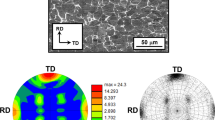Abstract
Crazing in glassy plastics is attributed to a stress-activated devitrification of a small amount of material at the tip of a chance nick or flaw, to a softer rubbery state. Subsequent cavitation of the softened material is then assumed to take place under the action of the same dilatant stress responsible for its formation. A transition to ductile yielding is proposed to occur when the material in the tip region undergoes large deformations before softening.
The proposed mechanism of crazing is shown to provide quantitative predictions for the magnitude of tensile stress at which crazing occurs, the increase in crazing stress with hydrostatic pressure, the transition at high pressures to a yielding process without crazing, the reduction in crazing stress in the presence of certain liquids and vapours and, to some extent, for the effects of temperature and pre-orientation. These theoretical predictions are found to be in reasonably satisfactory agreement with experiment. In view of the limited number of adjustable parameters in the theory (the principal one being the stress-magnification factor associated with a typical nick or flaw), this general agreement over a wide range of experimental conditions and variables suggests that the proposed mechanism of stress-crazing is basically correct.
Similar content being viewed by others
References
B. Maxwell andL. F. Rahm,Ind. Eng. Chem. 41 (1949) 1988.
C. C. Hsiao andJ. A. Sauer,J. Appl. Phys. 21 (1950) 1071.
O. K. Spurr, Jr, andW. D. Niegisch,J. Appl. Polymer Sci. 6 (1962) 585.
R. P. Kambour,Polymer 5 (1964) 143.
Idem, J. Polymer Sci. A2 (1964) 4159.
B. Biglione, E. Baer, andS. V. Radcliffe, “Fracture 1969: Proceedings of the Second International Conference on Fracture, Brighton, April 1969” (Chapman and Hall, London, 1969) p. 503.
D. R. Mears, andK. D. Pae,Polymer Letters 7 (1969) 349.
R. N. Haward, B. M. Murphy, andE. F. T. White, “Fracture 1969: Proceedings of the Second International Conference on Fracture, Brighton, April 1969” (Chapman and Hall, London, 1969) p. 519.
S. S. Sternstein andL. Ongchin, A.C.S. Polymer Preprints (Sept. 1969).
E. E. Ziegler,SPE Journal 10 (4) (1954) 12.
I. Wolock andD. George,ibid 12 (2) (1956) 20.
E. H. Andrews andL. Bevan, “Physical Basis of Yield and Fracture” (Institute of Physics & Physical Society, London 1967) p. 209.
G. A. Bernier andR. P. Kambour,Macromolecules 1 (1968) 393.
E. F. T. White, B. M. Murphy, andR. N. Haward,J. Polymer Sci. Part B7 (1969) 157.
A. C. Knight,ibid, Part A3 (1965) 1845.
J. D. Ferry andR. A. Stratton,Kolloid Z. 171 (1960) 107.
S. Newman andS. Strella,J. Appl. Polymer Sci. 9 (1965) 2297.
M. H. Litt andA. V. Tobolsky,J. Macromolecular Sci. B1 (1967) 433.
K. C. Rusch andR. H. Beck, Jr,ibid B3 (1969) 365.
C. E. Inglis,Trans. Instn. Naval Archit. 55 (1913) 219.
A. E. H. Love, “A Treatise on the Mathematical Theory of Elasticity”, 4th ed. (Cambridge University Press, London 1927).
M. S. Paterson,J. Appl. Phys. 35 (1964) 176.
J. D. Ferry, “Viscoelastic Properties of Polymers” (John Wiley and Sons, New York, 1961).
E. Passaglia andG. M. Martin,J. Res. Nat. Bur. Standards 68A (1964) 273.
A. N. Gent, andP. B. Lindley,Proc. Roy. Soc. (London) A249 (1958) 195.
A. N. Gent andD. A. Tompkins,J. Polymer Sci., Part A-27 (1969) 1483.
C. W. Stewart,ibid, Part A-28 (1970) 937.
A. N. Gent, andD. A. Tompkins,J. Appl. Phys. 40 (1969) 2520.
F. Bueche, “Physical Properties of Polymers” (Interscience, New York, 1962).
L. R. G. Treloar, “Physics of Rubber Elasticity”, 2nd. ed. (Oxford University Press, London, 1958) chap. 7.
E. H. Andrews andL. Bevan, Private communication.
D. W. Hadley, P. R. Pinnock andI. M. Ward,J. Mater. Sci. 4 (1969) 152.
C. Bridle, A. Buckley, andJ. Scanlan,ibid 3 (1968) 622.
M. W. Darlington andD. W. Saunders,J. Phys. D: Appl. Phys. 3 (1970) 535.
D. Hull, Private communication.
F. A. Mcclintock,J. Appl. Mech. 35 (1968) 363.
J. R. Rice andD. M. Tracey,J. Mech. Phys. Solids 17 (1969) 201.
K. C. Rusch,J. Macromol. Sci. B2 (2) (1969) 179.
S. S. Sternstein, L. Ongchin, andA. Silverman Appl. Polymer Symposia, No. 7. (1968) 175.
Author information
Authors and Affiliations
Additional information
On leave of absence from the University of Akron, Ohio, for the year 1969–70.
Rights and permissions
About this article
Cite this article
Gent, A.N. Hypothetical mechanism of crazing in glassy plastics. J Mater Sci 5, 925–932 (1970). https://doi.org/10.1007/BF00558171
Received:
Accepted:
Issue Date:
DOI: https://doi.org/10.1007/BF00558171



